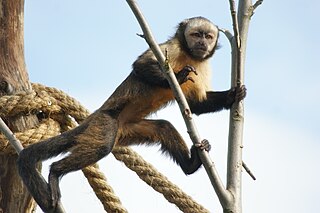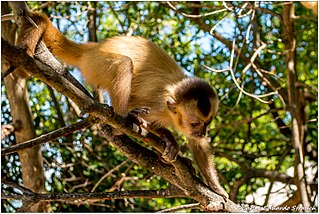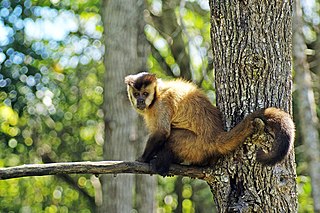
The Cebidae are one of the five families of New World monkeys now recognised. Extant members are the capuchin and squirrel monkeys. These species are found throughout tropical and subtropical South and Central America.

The Panamanian white-faced capuchin, also known as the Panamanian white-headed capuchin or Central American white-faced capuchin, is a medium-sized New World monkey of the family Cebidae, subfamily Cebinae. Native to the forests of Central America, the white-faced capuchin is important to rainforest ecology for its role in dispersing seeds and pollen.

The golden-bellied capuchin, also known as the yellow-breasted or buff-headed capuchin, is a species of New World or neotropical monkey. It lives mainly in trees and are omnivorous, eating a wide variety of both plant and animals as food. Golden-bellied capuchin normal home range is in the Atlantic forest of Brazil and it is critically endangered due to forest fragmentation and habitat loss mainly due to agriculture, there are currently efforts to protect them by the local government.

The capuchin monkeys are New World monkeys of the subfamily Cebinae. They are readily identified as the "organ grinder" monkey, and have been used in many movies and television shows. The range of capuchin monkeys includes some tropical forests in Central America and South America as far south as northern Argentina. In Central America, where they are called white-faced monkeys ("carablanca"), they usually occupy the wet lowland forests on the Caribbean coast of Costa Rica and Panama and deciduous dry forest on the Pacific coast.

Homunculus is an extinct genus of New World monkey that lived in Patagonia during the Miocene. Two species are known: Homunculus patagonicus and Homunculus vizcainoi, which are known from material found in the Santa Cruz Formation in the far south of Argentina.

Monkey is a common name that may refer to most mammals of the infraorder Simiiformes, also known as the simians. Traditionally, all animals in the group now known as simians are counted as monkeys except the apes, thus monkeys constitute an incomplete paraphyletic grouping; however, in the broader sense based on cladistics, apes (Hominoidea) are also included, making the terms monkeys and simians synonyms in regard to their scope.

The tufted capuchin, also known as brown capuchin, black-capped capuchin, or pin monkey, is a New World primate from South America and the Caribbean islands of Trinidad and Margarita. As traditionally defined, it is one of the most widespread primates in the Neotropics, but it has recently been recommended considering the black-striped, black and golden-bellied capuchins as separate species in a new genus, thereby effectively limiting the tufted capuchin to the Amazon basin and nearby regions. However, the large-headed capuchin, previously defined as a distinct species, has been reclassified as a subspecies of the tufted capuchin, expanding its range east to Peru & Ecuador and south to Bolivia.

The Kaapori capuchin, also known as the Ka'apor capuchin, is a species of frugivorous, gracile capuchin endemic to the Brazilian Amazon. Their geographical home range is relatively small and is within the most densely populated region of the Amazon. With the strong human presence nearby,C. kaapori has had to deal with very large amounts of disturbances to their habitat and is one of the most endangered of the neotropical primates.

The wedge-capped capuchin or Guianan weeper capuchin is a capuchin monkey from South America. It is found in northern Brazil, Guyana and Venezuela. Cebus olivaceus is known to dwell in tall, primary forest and travel over long distances during the day.
A facultative biped is an animal that is capable of walking or running on two legs (bipedal), as a response to exceptional circumstances (facultative), while normally walking or running on four limbs or more. In contrast, obligate bipedalism is where walking or running on two legs is the primary method of locomotion. Facultative bipedalism has been observed in several families of lizards and multiple species of primates, including sifakas, capuchin monkeys, baboons, gibbons, gorillas, bonobos and chimpanzees. Different facultatively bipedal species employ different types of bipedalism corresponding to the varying reasons they have for engaging in facultative bipedalism. In primates, bipedalism is often associated with food gathering and transport. In lizards, it has been debated whether bipedal locomotion is an advantage for speed and energy conservation or whether it is governed solely by the mechanics of the acceleration and lizard's center of mass. Facultative bipedalism is often divided into high-speed (lizards) and low-speed (gibbons), but some species cannot be easily categorized into one of these two. Facultative bipedalism has also been observed in cockroaches and some desert rodents.

The blond capuchin is a species of capuchin monkey endemic to northeastern Brazil. This endangered species was rediscovered in 2006. It can live in exceptionally large groups of over 150 individuals, and like other capuchin species, exhibits a complex and high level of sociality. It is threatened by loss of habitat due to agriculture, primarily sugarcane fields. In many cases this has caused sugarcane to make up a large portion of their diet, which would otherwise consist of mostly fruit and small animals. The blond capuchin is known to inhabit both the Atlantic forest and Caatinga biomes, although the habitation of the Caatinga may be a recent choice caused by human encroachment into its former habitats. Like other primate species, the blond capuchin is also threatened by poaching and capture for the illegal pet trade.
Solimoea acrensis is a prehistoric ateline monkey from the Late Miocene Solimões Formation of Brazil. It is the only known species of the genus Solimoea.

Robust capuchin monkeys are capuchin monkeys in the genus Sapajus. Formerly, all capuchin monkeys were placed in the genus Cebus. Sapajus was erected in 2012 by Jessica Lynch Alfaro et al. to differentiate the robust (tufted) capuchin monkeys from the gracile capuchin monkeys, which remain in Cebus.

Gracile capuchin monkeys are capuchin monkeys in the genus Cebus. At one time all capuchin monkeys were included within the genus Cebus. In 2011, Jessica Lynch Alfaro et al. proposed splitting the genus between the robust capuchin monkeys, such as the tufted capuchin, and the gracile capuchins. The gracile capuchins retain the genus name Cebus, while the robust species have been transferred to Sapajus.

The crested capuchin or robust tufted capuchin is a species of robust capuchin monkey. It is endemic to Brazil. It was formerly considered a subspecies of the black capuchin but is now considered by some to be a separate species.

Azaras's capuchin or hooded capuchin is a species of robust capuchin. It occurs in eastern Paraguay, southeastern Bolivia, northern Argentina, and Brazil, at Mato Grosso do Sul and Mato Grosso states, in Pantanal. Its habitat consists of subtropical, humid, semi-deciduous, gallery forests and forested regions of the Pantanals. Formerly, it was considered a subspecies of black-striped capuchin, according to Groves (2005) with the name Cebus libidinosus paraguayanus, but Silva Jr. (2001) considered it a separated species. They are considered as frugivores-insectivores which means that their diet mainly consists of a variety of fruits, seeds, arthropods, frogs, small mammals, etc.

Humboldt's white-fronted capuchin is a species of gracile capuchin monkey. It is found in Colombia, Venezuela, Brazil, and potentially the island of Trinidad.

The brown weeper capuchin or Venezuelan brown capuchin is a species of gracile capuchin monkey endemic to Venezuela, although some sources also consider it to occur on Trinidad.

The Trinidad white-fronted capuchin is a subspecies or species of gracile capuchin monkey. It is found on the island of Trinidad.
Primate archaeology is a field of research established in 2008 that combines research interests and foci from primatology and archaeology. The main aim of primate archaeology is to study behavior of extant and extinct primates and the associated material records. The discipline attempts to move beyond archaeology's anthropocentric perspective by placing the focus on both past and present primate tool use.













